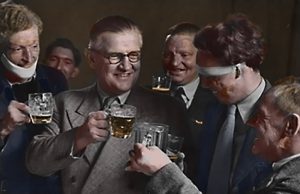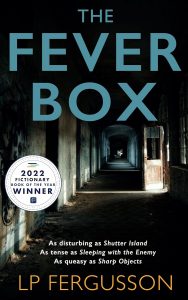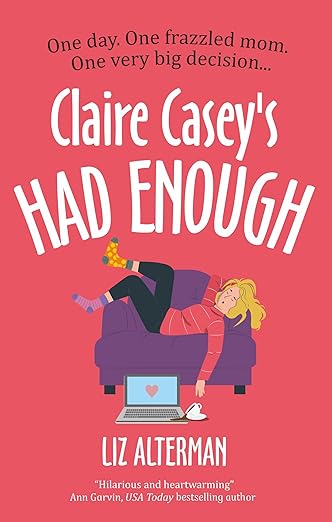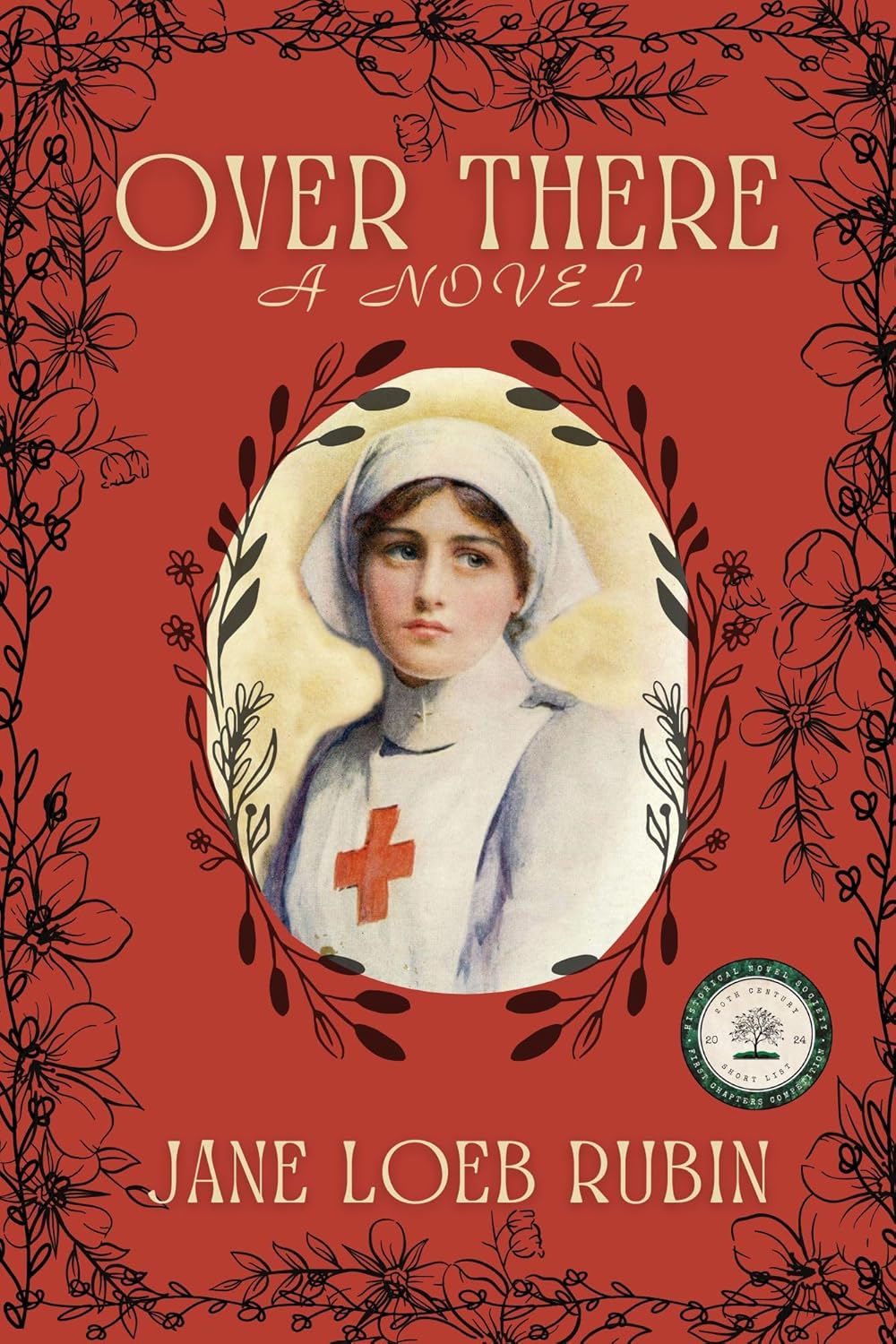The Guinea Pig Club
The Guinea Pig Club

MacIndoe and Patients.jpg: Archie McIndoe (centre) with his “boys” enjoying a pint (courtesy of The Guinea Pig)
The Fever Box is a psychological thriller set in a military hospital during WW2. One of the main characters is Dougie Douglas, a badly-burned pilot shot down during the evacuation of Dunkirk, who eventually becomes a member of the elite Guinea Pig Club, created in 1941 by a group of RAF pilots. You could only join if you’d been “boiled, mashed or fried” in a plane crash and treated in Ward III of East Grinstead Cottage Hospital. It was here that the brilliant plastic surgeon Archie McIndoe reconstructed the faces and hands of these young men.
Known by his work colleagues and patients as The Boss or The Maestro (and not infrequently as God) McIndoe was a force of nature. He was a tireless workaholic as well as a virtuoso in the operating theatre and despite his deep connections with the RAF, he maintained his civilian status, leaving him free to harry the necessary authorities and get the things he needed for his “boys”. He was obsessively attached to his patients and their care, but he could often be a bully with his staff and patients’ families.
He was not slow to use forthright aggression to get his own way, but he could also be charming and persuasive, characteristics that were vital in persuading the people of East Grinstead to help him rebuild the confidence of his patients to face the world. Instead of hiding away from society as so many badly injured men had done in the previous war, McIndoe ensured that the country acknowledged them for the heroes they were, living proof of courage and an ability to endure, whatever the challenges. East Grinstead became known as “the town that didn’t stare”.

Guinea Pig Badge. The club stated the metal badge could only be worn by allied aircrew who had undergone at least two operations at East Grinstead for burns or other crash injuries; doctors, surgeons and members of medical staff at East Grinstead; and friends and benefactors who had made the life of a Guinea Pig a happy one.
First-hand accounts written at the time are invaluable to a historical fiction writer. The seam for me was rich – Richard Hillary’s The Last Enemy, Geoffrey Page’s Tale of a Guinea Pig, William Simpson’s I Burned My Fingers and Tom Gleave’s I Had a Row with a German – but as the latter two titles imply, the style of writing epitomised the attitudes of the time, to make a joke of things, never to complain, and to bloody well get on with it. It was vital that I read between the lines in order to imagine the profound effect these experiences had on a young man such as Dougie and to understand the deep psychological impact of facial disfigurement. I was left in awe of these young men.
I have often thought how difficult it must have been for McIndoe to rebuild the hands and faces of these men only to see them return to active duty, but that was his brief, and often their fierce desire. He did not think Richard Hillary was fit to fly, the injuries to his hands dramatically compromised his dexterity, but Hillary charmed and bullied other doctors and various RAF authorities into letting him back in a plane. During a night training flight in 1943, he crashed a Bristol Blenheim night fighter and died along with the navigator and radio operator.
Geoffrey Page also returned to operational flying, with much greater success. Determined to bring down as many enemy planes as he’d had operations to rebuild his face and hands, he teamed up with another disabled pilot, Squadron Leader James MacLachlan, who had lost his arm during an air battle over Malta. They came up with the plan of making early morning low-level sorties over occupied France and taking German aircraft out from underneath. The Mustangs were painted dark green and flew over occupied territory at tree height.
The plan was a success. On their first sortie they despatched six enemy aircraft during the first ten minutes. Tragically, MacLachlan’s plane was hit during the second sortie and crash landed. Critically injured, he was taken prisoner by the Germans and hospitalised in France, but two weeks’ later he died of his wounds.
Page returned to East Grinstead to have further work on the scar tissue of one of his hands and in January 1944 he took over command of 132 Squadron. When the long awaited invasion of Europe began, Page – by now aged twenty-four – said he felt like an old man compared to the young pilots he was commanding and training, but he continued flying support mission for the 1st Airborne Division at the Battle of Arnhem.
He was again badly injured during a crash landing and returned to McIndoe for further operations, but by the time Germany surrendered, he had achieved his ambition – he had shot down ten enemy planes on his own, five with other pilots and damaged a further three. The citation for his Distinguished Service Order said that he had “infused the entire wing with his fighting spirit. Under his command sixty enemy aircraft have been destroyed.” Later he became well known in the United States from his lecture tours, and when he returned, he joined Vickers-Armstrongs as a test pilot. He dedicated his autobiography to Archie McIndoe, “whose surgeon’s fingers gave me back my pilot’s hands.”
When I began researching and writing The Fever Box there were seven living Guinea Pigs. The last two, Flight Sergeant Sam Gallop and Lieutenant Jan Stangrycuk-Black died in 2023, both aged 101, but the success of the camaraderie and support among those WW2 pilots was directly responsible for the creation of the CASEVAC Club in 2017 (short for “casualty evacuation”) for men and women seriously injured in Iraq and Afghanistan.
In the course of my research, I saw many clinical photographs of dreadful disfigurements along with the equally frightening changes wrought by the multiple surgeries the Guinea Pigs had to endure. I have also watched innumerable archived interviews with them, talking over the years about the Club and their wartime experiences. As I watched these men age, the scars, skin grafts and strange muscle movements softened, and their personalities shone out once again, their authentic characters undimmed.
The Fever Box by L P Fergusson is published 4 January 2024 and available on Amazon
LP Fergusson grew up in Great Britain on the borders of Wales in a Tudor house on the banks of the River Wye. As LP Fergusson she writes serious historical fiction dealing with the Second World War and the War of Spanish Succession. As Loraine Fergusson she writes cozy mysteries inspired by her time working in one of England’s major stately homes, Blenheim Palace in Oxfordshire. The Archivist (2012) was the first novel in the Duntisbourne Hall series, The Golden Hand (2013) the second, and The Hipkiss File (2023) the third.
She has an MA in Creative Writing with Distinction from Oxford Brookes University and won the Blackwell’s Prize for MA Creative Writing 2015. Her manuscript The Fever Box won Fictionary Book of the Year 2022. For five consecutive years her short fiction has made it through Round 1 of NYC Midnight, winning first place twice. She has been shortlisted by the Orwell Society, published by Oxfordshire Libraries, and her psychological thriller A Serpent’s Tooth reached the final of the joint Quercus/Psychologies Thriller competition.
She is the editor of the blog With Love from Graz, which was featured on BBC Radio Wales, Radio 2 and the BBC4 programme A Very British Romance with Lucy Worsley.
THE FEVER BOX
 A psychological thriller with the disturbing setting of Shutter Island, the threatening tension of Sleeping with the Enemy and the queasy twist of Sharp Objects.
A psychological thriller with the disturbing setting of Shutter Island, the threatening tension of Sleeping with the Enemy and the queasy twist of Sharp Objects.
When Clara Cooper’s abusive husband is lost in action during the Fall of France, she grabs the opportunity to disappear, secretly returning to nursing. Although Britain is on the brink of invasion, she finds a comforting anonymity working in the vast military hospital on the south coast. However, more than pain and suffering lurk in the misty corridors.
Who is the mysterious girl Clara nurses through a barbaric night of treatment in the ‘fever box’? And who is haunting the opium dreams of badly-burned pilot Dougie Douglas? As frightening and malevolent events accelerate, Clara becomes convinced that her husband has returned, forcing her to face a danger far greater than anything the nightly bombing raids can bring.
BUY HERE
Category: On Writing






























